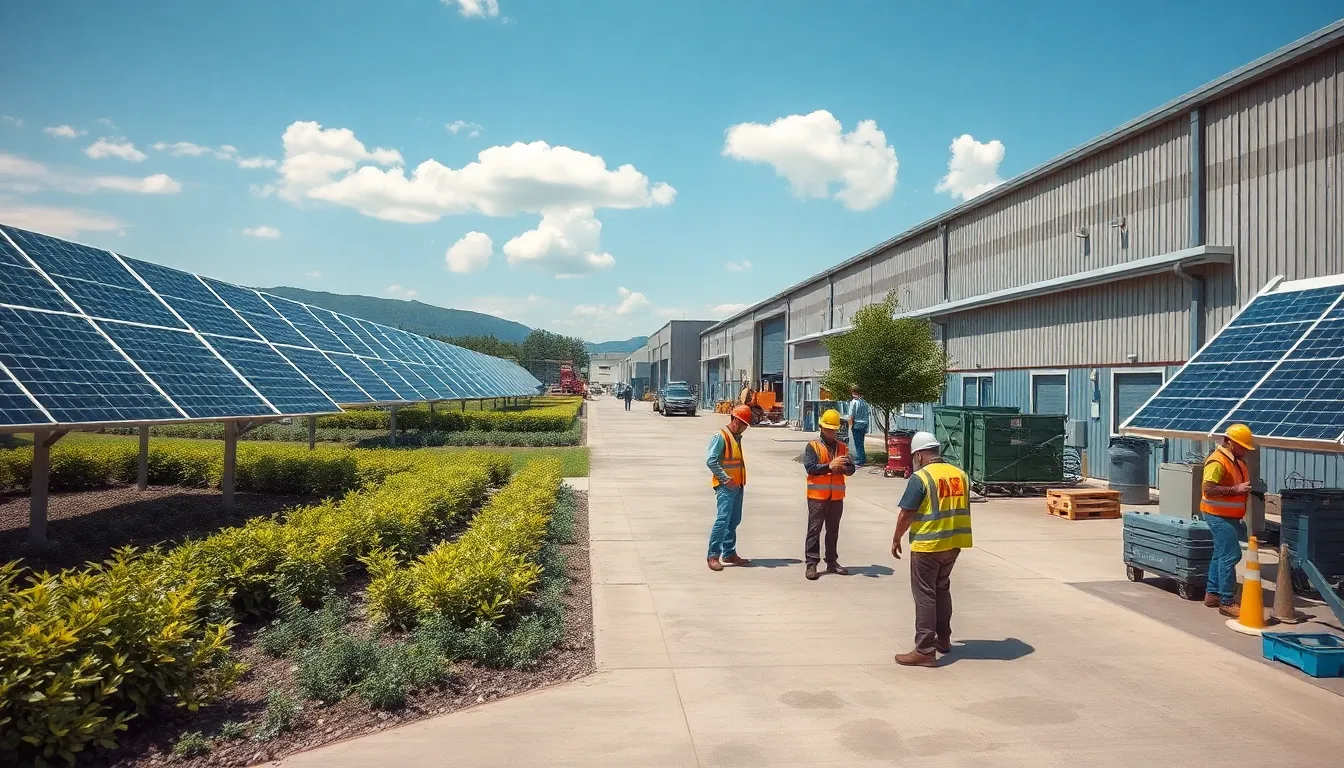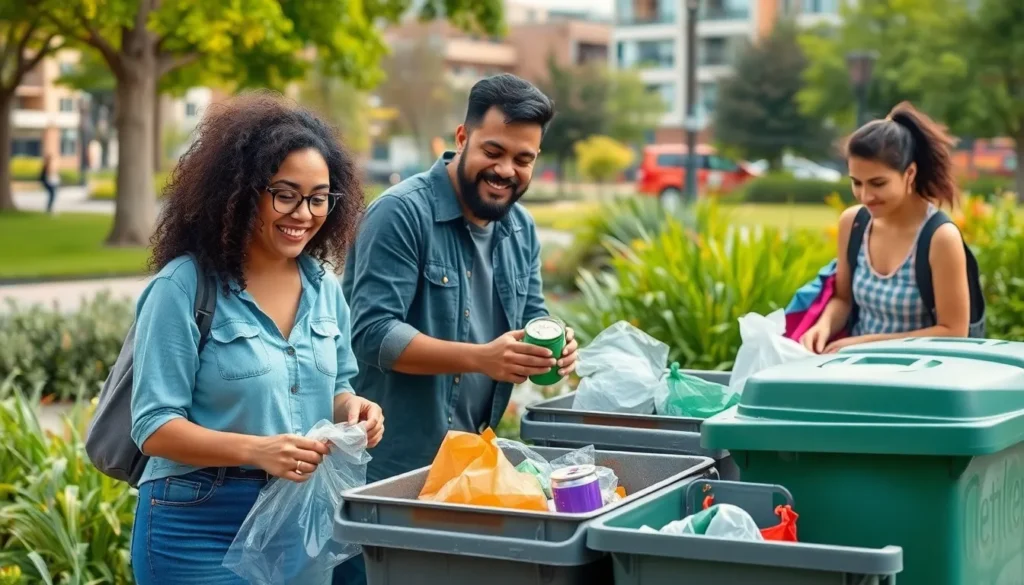Table of Contents
ToggleImagine a world where waste is a thing of the past, and every product has a second life. Welcome to the circular economy, where recycling isn’t just a buzzword but a way of life. In this innovative model, the focus shifts from a linear “take-make-dispose” approach to one that keeps resources in play, reducing waste and maximizing value.
What Is Circular Economy?
Circular economy refers to an innovative economic model that prioritizes resource efficiency and sustainable practices. This approach aims to eliminate waste and ensure that products are designed for continuous reuse or recycling.
Definition and Principles
Circular economy involves a shift from the traditional linear model of production. Emphasis lies on minimizing waste, maximizing resource use, and promoting sustainability. Key principles include designing for longevity, reusing materials, and embracing renewable resources. This model reduces environmental impact while fostering economic growth and job creation.
Historical Context
The concept of circular economy traces its roots back to early sustainability movements. In the 1960s, awareness grew around environmental issues and resource depletion. By the 1990s, scholars began formalizing the circular economy framework. Over the years, global awareness has increased, prompting businesses and governments to adopt circular practices. Today, many countries incorporate circular economy principles into their policies to drive sustainable development.
Benefits of Circular Economy

The circular economy offers significant advantages across environmental and economic dimensions. It enhances sustainability while promoting resource efficiency.
Environmental Advantages
Reducing waste ranks among the primary benefits of the circular economy. Emphasizing materials’ reuse lessens the strain on natural resources. Minimizing resource extraction decreases pollution and habitat destruction, promoting biodiversity. Utilizing renewable energy sources further lowers carbon emissions and fosters cleaner production methods. Energy-efficient practices also contribute positively to the environment through reduced energy consumption. Studies show that implementing circular economy principles can cut global greenhouse gas emissions significantly by up to 70% by 2050.
Economic Impacts
Economic growth finds a strong ally in the circular economy model. Job creation emerges as companies transition towards sustainable practices. Research indicates circular approaches can generate 4.5 million jobs in Europe by 2030. Businesses see cost savings from increased efficiency and reduced waste. Revenue streams diversify through innovative recycling and repurposing businesses. As a result, investments in sustainable technologies foster broader economic resilience. Ultimately, the circular economy supports sustainable growth while securing resource availability for future generations.
Challenges of Implementing Circular Economy
Implementing a circular economy presents several challenges that hinder its widespread adoption. Addressing these obstacles requires considerable effort across various sectors.
Technological Barriers
Emerging technologies play a crucial role in transitioning to a circular economy. Many companies face difficulties accessing advanced recycling systems and innovative materials. Limited investment in research and development can lead to ineffective recycling processes. Additionally, existing manufacturing methods often lack the flexibility needed for circular production techniques. Companies may find resistance to adopting new technologies due to high initial costs. Resistance to change can also stem from a lack of understanding of long-term benefits. Ultimately, resolving these technological barriers promotes efficient resource use and overall economic stability.
Policy and Regulation Issues
Regulatory frameworks significantly impact circular economy initiatives. Many countries lack comprehensive policies that support circular practices, resulting in inconsistencies. Unclear regulations can create confusion for businesses trying to navigate compliance. Governments may not incentivize sustainable practices, discouraging companies from adopting circular models. Existing waste management regulations often favor linear approaches, which hinders the shift toward circularity. Collaboration between government entities and industry stakeholders remains essential for developing effective policies. Enacting supportive regulations encourages sustainable practices, fostering economic growth and environmental responsibility.
Examples of Circular Economy in Action
Circular economy practices are increasingly visible across various sectors. Diverse applications demonstrate how businesses can minimize waste while maximizing resource efficiency.
Case Studies from Various Industries
In the fashion industry, brands like Patagonia lead with their take-back programs, allowing customers to return used garments for repair or recycling. IKEA has adopted circular practices by using sustainable materials in its products and designing modular furniture that encourages reuse. In the electronics sector, Apple implemented a recycling program called “Daisy,” capable of disassembling iPhones to recover valuable materials. These case studies highlight how companies can effectively adopt circular economy principles, ultimately driving sustainability and profitability.
Innovative Practices
Innovative models include the sharing economy, exemplified by companies like Airbnb and Zipcar. These platforms promote resource sharing, enabling users to access products without ownership, which reduces waste. Another practice involves remanufacturing, where companies refurbish used products to extend their life cycle, evident in manufacturers like Caterpillar. Additionally, companies are engaging in industrial symbiosis, where the waste of one company becomes the raw material for another. Such innovative practices exemplify the potential of the circular economy to foster sustainable growth while enhancing environmental responsibility.
Embracing the circular economy represents a transformative shift towards sustainability. By prioritizing resource efficiency and minimizing waste, this model not only benefits the environment but also stimulates economic growth. As businesses and governments collaborate to overcome challenges and implement circular practices, the potential for innovation and job creation expands.
The examples of successful circular initiatives across various sectors highlight the feasibility and advantages of this approach. With a collective commitment to sustainable development, the circular economy can pave the way for a resilient future, ensuring that resources remain available for generations to come. The journey towards a circular economy is just beginning, and its impact could redefine how society interacts with the environment.







